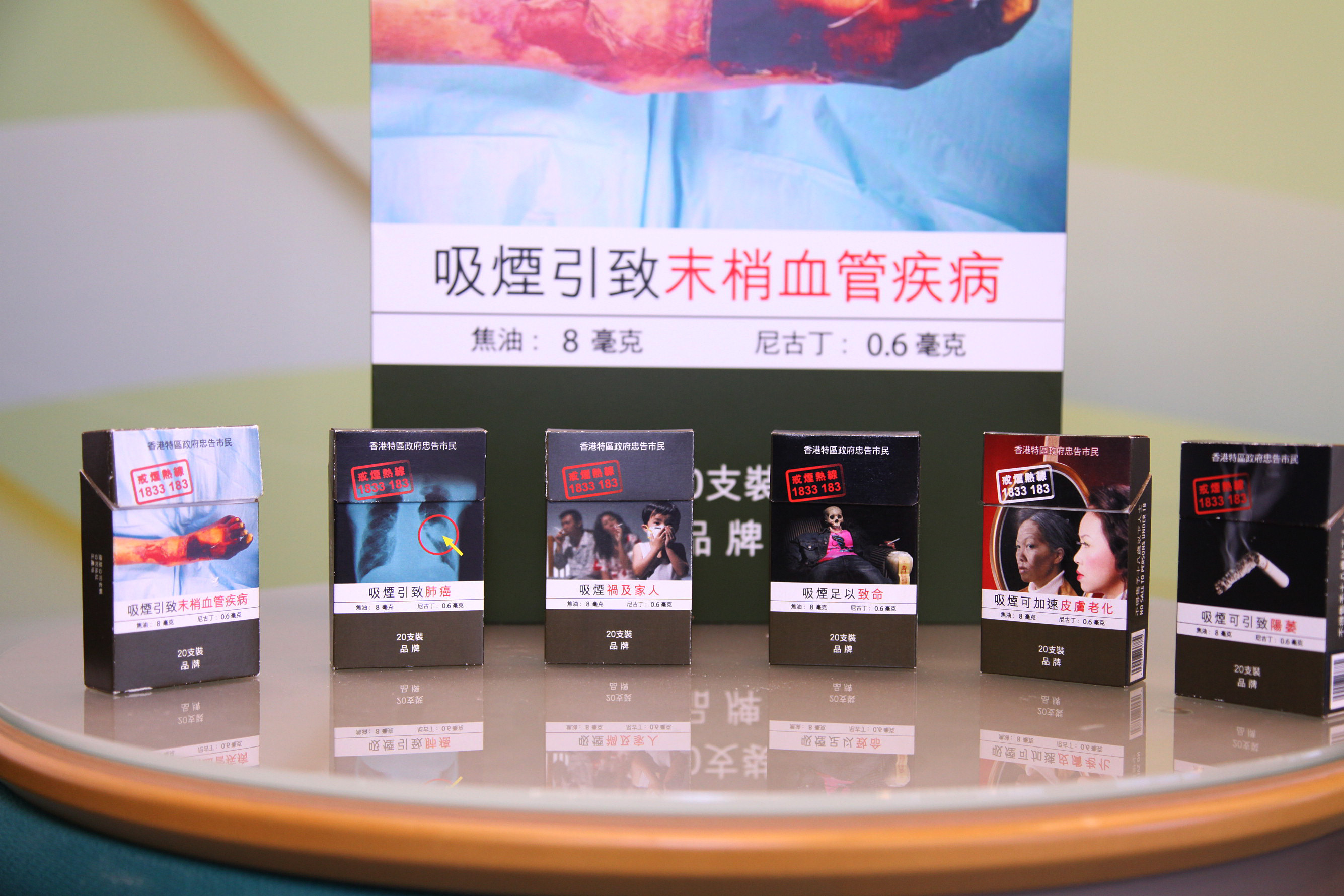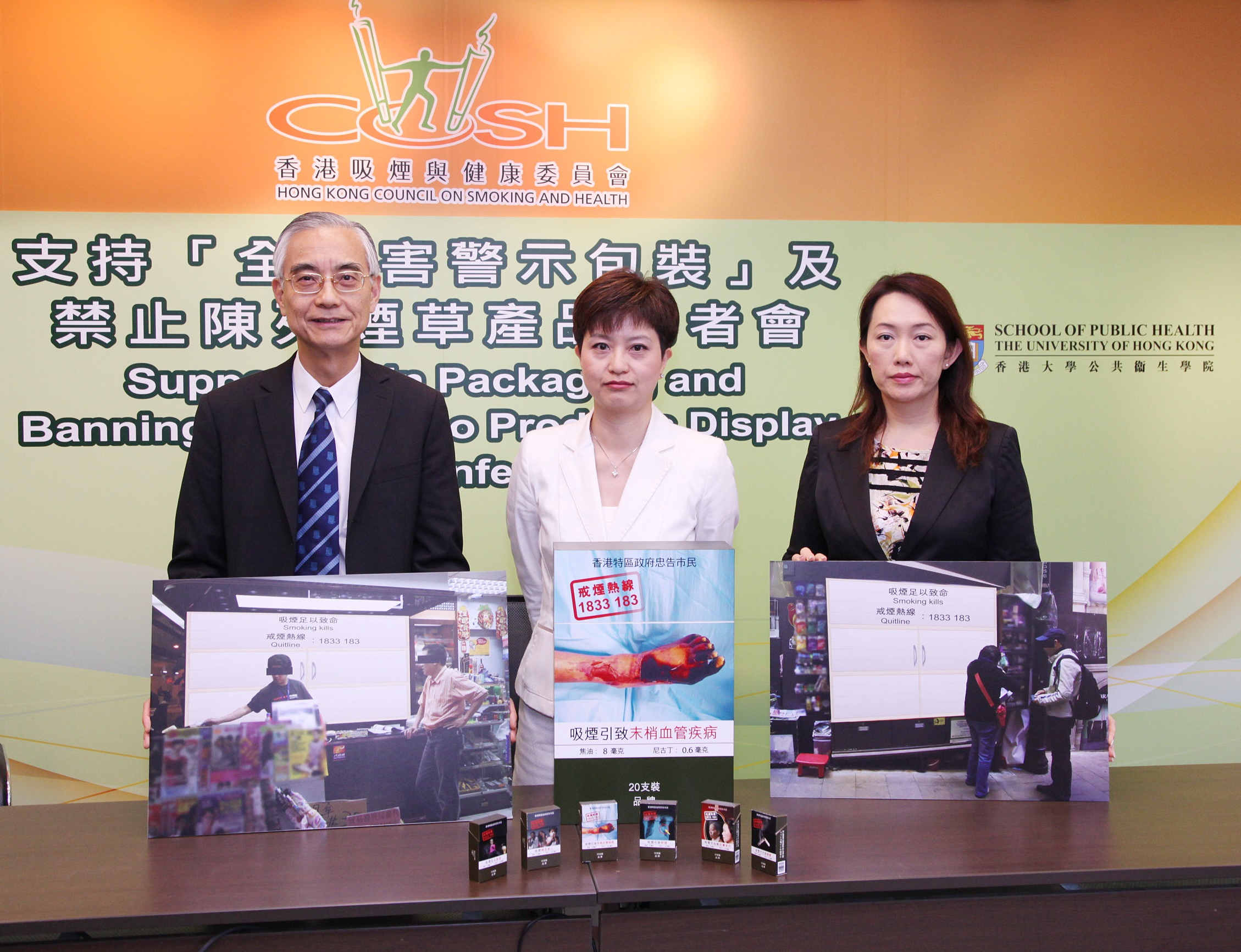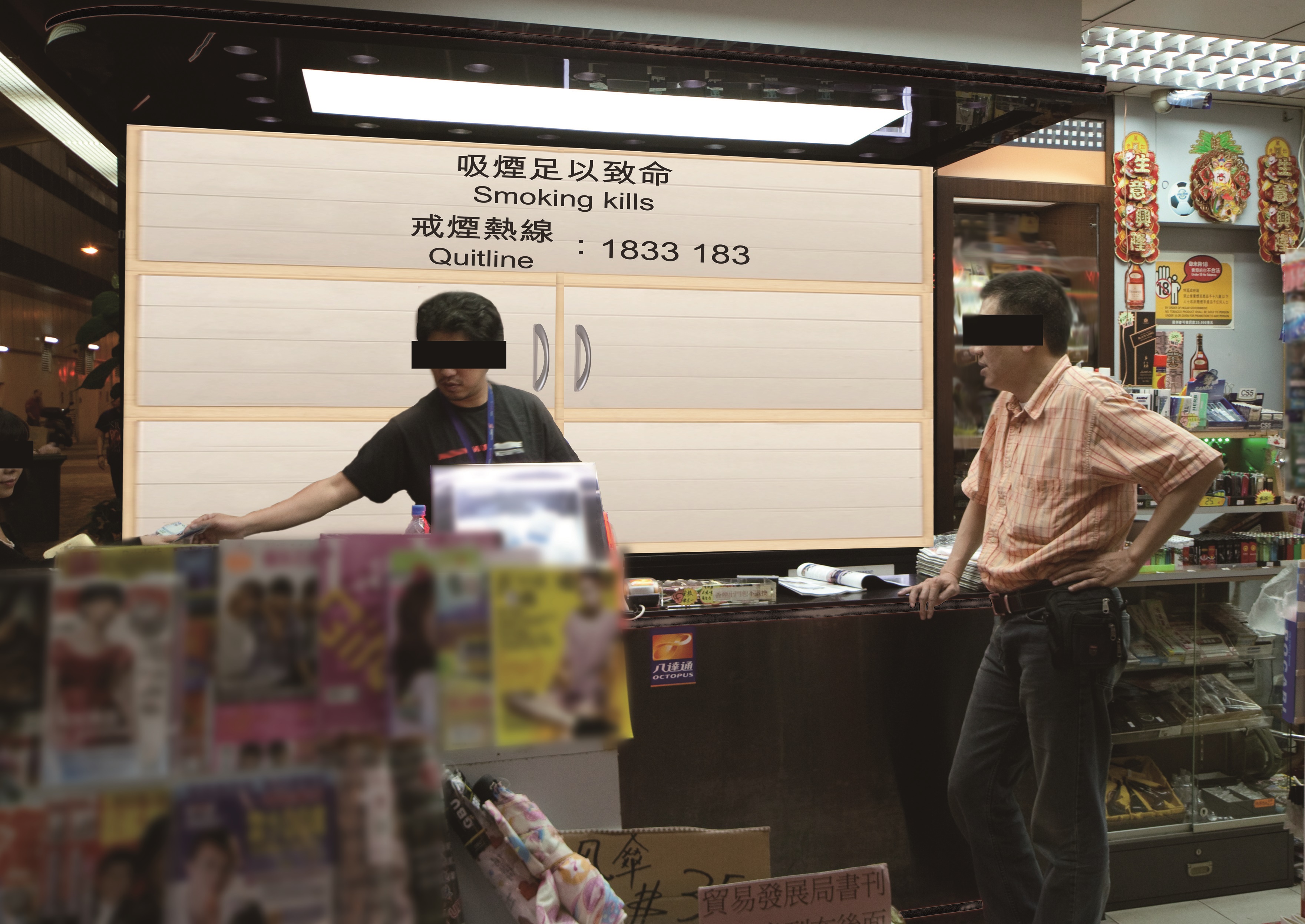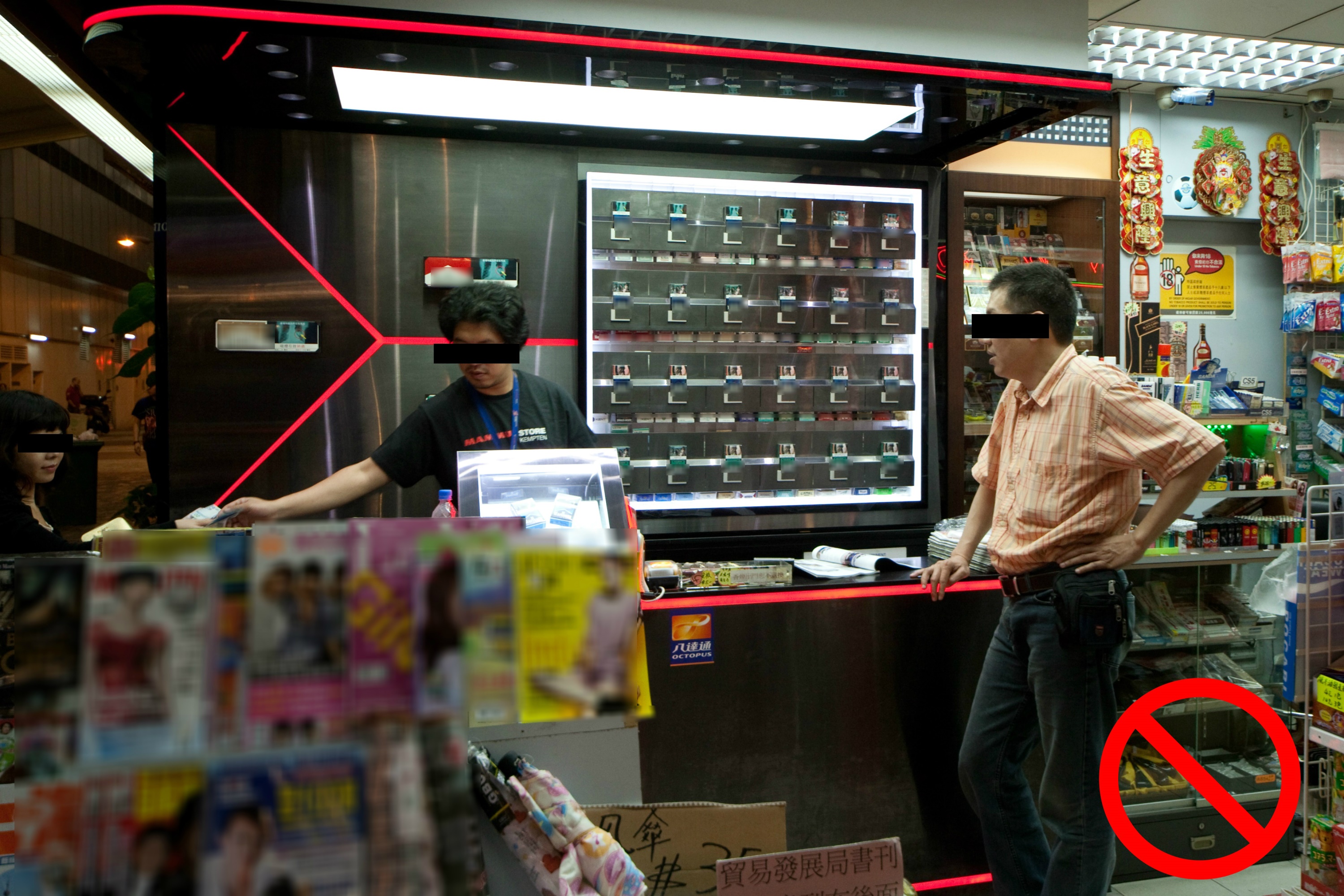The World Health Organization (WHO) has designated "Ban tobacco advertising, promotion and sponsorship" as the theme of this year’s World No Tobacco Day (31 May) which aims to urge governments to implement a comprehensive ban on all forms of tobacco advertising, promotion and sponsorship; to raise public awareness on the marketing tactics of tobacco industry; and to encourage smokers to free themselves from the manipulation of tobacco. Lisa LAU, MH, JP, Chairman of Hong Kong Council on Smoking and Health (COSH) says, “In response to the World No Tobacco Day, COSH advocates the Government to implement plain packaging and ban tobacco products display to prohibit all tobacco advertising and promotion which can prevent teenagers from picking up smoking and encourage more smokers to kick the habit.”
Since the implementation of the Smoking (Public Health) Ordinance in 1982, tobacco advertising, promotion and sponsorship have been gradually prohibited in Hong Kong. All tobacco advertisements on TV, radio, printed media and internet, as well as display advertisements were banned. Tobacco companies were not allowed to sponsor sports events and music videos. It was also prohibited to promote the sale of tobacco products by means of offering prizes, gifts, tokens or raffle in exchange for any valuable items. After amendment of the Ordinance in 2006, the exemption for display of tobacco advertisement in small-scale retail outlets and hawker stalls were withdrawn and pictorial health warnings on cigarette packets were introduced. Vienna LAI, MPH, COSH Executive Director remarks, “Despite the Ordinance has banned all tobacco advertising and sponsorship on various platforms, tobacco industry still exploits loopholes to promote their products, such as different packaging of tobacco products and large, prominent and visually appealing display of products at points of sale.”
COSH actively advocates the implementation of plain packaging and banning on tobacco products display to counteract the marketing tactics of tobacco industry. COSH has commissioned School of Public Health of The University of Hong Kong to conduct a survey to collect public views on the related policies. The survey was conducted from 26 March 2013 to 29 April 2013 and a total of 851 citizens aged between 15 and 65 were interviewed. 78.4% of the respondents were never smokers, 12.7% were ex-smokers and 8.9% were current smokers.
According to the survey findings, more than half of the respondents (50.7%) agreed to the plain packaging of cigarette products. 35.7% of ever smokers (current and ex-smokers) said that the pictorial health warnings made them think of the risks of smoking whereas 91% did not think of quitting because of the pictorial health warnings. Nearly 60% (59.9%) of respondents thought that warnings should be clearer. Prof LAM Tai-hing, BBS, JP, Director of School of Public Health, Sir Robert Kotewall Professor in Public Health, The University of Hong Kong explains, “The survey findings reflect that current pictorial health warnings have some effects on delivering the message of smoking hazards and cessation. But the effectiveness has to be enhanced by strengthening and expanding the pictorial health warnings.”
Regarding the ban on tobacco products display, nearly half of all respondents (48.4%) agreed on total ban on display of tobacco products at points of sale while more than half of them (52.5%) considered tobacco products display in stores as a kind of advertisement and promotion. Around 30% (29.2%) of current smokers wanted to smoke after seeing the display of tobacco products at points of sale.
According to WHO Framework Convention on Tobacco Control Article 13, “Packaging and product design are important elements of advertising and promotion…… adopting plain packaging requirements to eliminate the effects of advertising or promotion on packaging”, “Display of tobacco products at points of sale in itself constitutes advertising and promotion”. Plain packaging and banning tobacco products display are the global trend on tobacco control. Australia has already implemented plain packaging since December 2012 while Ireland and New Zealand have begun the process of introducing plain packaging. Tobacco products display has been banned in Iceland, Thailand, Canada, Ireland, Norway, Australia and other countries.
 Plain packaging standardizes and simplifies the packaging of tobacco products. The pictorial health warnings are expanded from 50% to 75% or above of the main sides of the cigarette pack. All forms of tobacco branding should be labeled according to the government prescriptions and with simple unadorned format. This entails that trademarks, graphics and logos be detached from cigarette packs, except for the brand name that is displayed in a standard font size, colour and location on the package. The packaging should not contain other colour and should include only the content and consumer information, such as toxic constituents, and health warnings required by law. Quitline should also be displayed at a prominent position. By standardizing the packaging and expanding the pictorial health warnings, it is hoped that the misconceptions about relative harmfulness of various cigarette brands can be corrected; up-take of smoking among teenagers and women can be prevented; the overall appeal of smoking can be reduced and hence lowering smoking prevalence.
Plain packaging standardizes and simplifies the packaging of tobacco products. The pictorial health warnings are expanded from 50% to 75% or above of the main sides of the cigarette pack. All forms of tobacco branding should be labeled according to the government prescriptions and with simple unadorned format. This entails that trademarks, graphics and logos be detached from cigarette packs, except for the brand name that is displayed in a standard font size, colour and location on the package. The packaging should not contain other colour and should include only the content and consumer information, such as toxic constituents, and health warnings required by law. Quitline should also be displayed at a prominent position. By standardizing the packaging and expanding the pictorial health warnings, it is hoped that the misconceptions about relative harmfulness of various cigarette brands can be corrected; up-take of smoking among teenagers and women can be prevented; the overall appeal of smoking can be reduced and hence lowering smoking prevalence.
The set of six pictorial health warnings have been used in Hong Kong since it was first introduced in 2007 and their warning effect has been faded out. COSH proposes to adopt a new set of pictorial health warnings with stronger effects and amend regularly to optimize the effectiveness and raise the consumers’ awareness on smoking hazards and cessation. COSH also advocates the Government to authorize the Department of Health to update the pictorial health warning on a regular basis.
Display of tobacco products is now a key means of promoting tobacco products and tobacco use which gives the impression that tobacco use is socially acceptable and making it harder for tobacco users to quit. Young people are particularly vulnerable to the promotion effects of product display. COSH advocates a total ban on any display and on the visibility of tobacco products at points of sale, including fixed retail outlets and news stand is to ensure that they do not have any promotional elements. Only the textual listing of products and their prices, without any promotional elements, would be allowed.
“To enhance the effectiveness on tobacco control, Hong Kong should follow the global trend. COSH will conduct study and public education on adopting plain packaging and banning tobacco products display. We will also seek public support to the legislation of related policies and advocate the Government to enhance other tobacco control measures such as expansion of statutory no smoking areas and raising tobacco tax.” Lisa LAU says. COSH hopes that the smoking prevalence continues to drop to below 5% by 2022 and let’s strive for a smoke-free Hong Kong with a total ban on tobacco products sale.
Photo Captions:

Photo 1:COSH advocates the implementation of plain packaging and banning on tobacco products display.

Photo 2:Plain packaging: expanding the health warnings 75 per cent of the main sides of cigarette pack, no branding and other design features allowed, with smoking cessation hotline at prominent position.

Photo 3(After):Tobacco products display should be banned. Only the textual listing of products and their prices, without any promotional elements, would be allowed.

Photo 3(Before):Tobacco industry exploits loopholes to promote their products through visually appealing display of products at points of sale.
